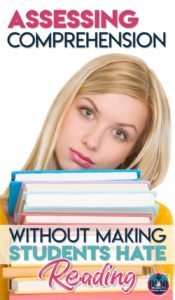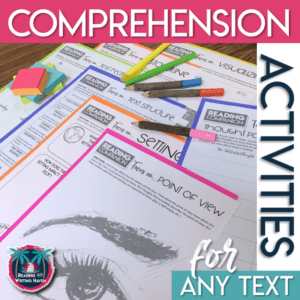6 Ways to Assess Comprehension without Making Students Hate Reading
Searching for ways you can assess comprehension without making your students groan? You want to hold students accountable and assess their understanding, but you don’t want to make them hate reading. I get it. There is a fine line between love and hate, even in this context.
Have you ever noticed that students often love reading in elementary school, but their feelings toward it slowly spiral downward as they grow older? In The Read Aloud Handbook, Jim Trelease writes that every child begins school wanting to learn to read. However, only 54% of fourth graders read for pleasure daily. Only 30% of eighth graders read for enjoyment daily, and by twelfth grade, the average is down to 19%. I believe part of the reason for this decline in attitude and interest is due, in part, to the ways we often assess comprehension.
The pressures of standardized testing have caused shifts in teaching trends. For example, some schools use programs like Accelerated Reader because they want a way to hold students accountable. Reading logs are common as a way to track and record number of books and pages read. Students are assigned challenging texts that are part of standards-aligned collections but that are not always relevant or interesting. While we can glean some information about how a student reads and comprehends through these means, they don’t do much in the way of shaping lifelong readers.
Is it possible to assess reading comprehension in middle and high school without the negative stigma? I believe it is. Let’s take a look at a handful of approaches.
Note: These strategies can be used with whole-class texts and choice reading situations.
Add variety.
One of the biggest mistakes I’ve made when it comes to assessing reading is asking students to complete the same tasks for every book or text. Work doesn’t feel so awful when we are learning something new, able to express ourselves in different ways, and given the freedom of choice. When assessing students’ comprehension, try to incorporate options but also variety. Don’t give them the same choice(s) every time they finish a book. Variety keeps things fresh and allows students to learn more about themselves as readers.
Book talk it.
One of the easiest ways to assess how students are thinking about a book is by asking them to talk briefly about it. One way I’ve done this successfully is to call on students randomly after silent reading. I give students a simple prompt so that it’s easy for them to begin talking (Examples: The part of my book I like most today is…, This book reminds me of my own life because…, or What’s currently happening in my book is…). Here are some additional grab and gab prompts for narratives.
The point of this time is twofold:
1 – Students are held accountable for reading, and I get to hear how they are comprehending their book.
2 – Students have the opportunity to “sell” their book to their classmates who might want to read it next.
Discuss in groups.
When my students participate in book club, the reading is in addition to our regularly scheduled content. Still, I set aside ten minutes each day for them to engage with their books. As such, I want to make sure they are reading and comprehending those texts.
So, I let them discuss their books in group at the end of the month. They bring in food and have book club discussions, and I sit with each group to listen as they respond to a variety of fiction and nonfiction discussion prompts. They have other opportunities to talk about their books, but this final discussion day is low pressure, and it helps them develop positive associations with reading. Plus, it gives me a picture of their progress. You can use small group discussions with whole class texts in similar ways.
Confer individually.
In order to really get to know your readers, it’s helpful to make time to confer with each student individually. You can ask them to read to you during this time (to note behaviors and patterns), to talk to you about what they are reading (to assess comprehension), and to give them a quick minilesson on a specific skill. Using during and post-reading comprehension activities that are short and scaffolded reduces the frustration and the negative association that often ensues with older students when reading.

Respond to fun prompts.
Asking students to write about what they are reading is important, but if they have to write about what they read every time, it becomes a chore. Here are 20 thoughtful and relevant prompts you can use with secondary students. Add some variety by throwing in a scaffolded one pager, a mind map, a book snap, a children’s book adaptation, a graphic organizer, or sketch notes option ocassionally.
Exit Slips
If you begin reading a story together as a class and then ask students to finish reading it on their own, you may want to assess their comprehension before they leave the room. Why? It will give you an idea of whether the text is at students’ independent, instructional, or frustration level. This way, you will be able to plan appropriate scaffolding and support for the next class period. It will also allow you to notice any common deficits. For instance, maybe half the class is not able to make important inferences about the main character’s motivation.
Give students an exit slip that will allow them to show you how they are thinking about the text. The exit slip can be the data piece that helps you to gather that information in way that won’t intimidate or overwhelm students. These comprehension bookmarks are one form of exit slip you could collect. Another would be asking them to respond to one of these turn and talk task cards.
But, it can’t all be fun and games, right?
Of course, I wholeheartedly agree that middle and high school readers need to be held accountable and challenged. They need to be able to read, comprehend, write about, and discuss complex texts.
Sometimes, it’s important to ask students to reread a text to try to track the theme on their own. Whether or not students have the stamina and perseverance to think critically about and work through a difficult text independently is important. However, does that mean that read alouds, reading for pleasure, and choice reading are not worthwhile?
If we can’t make time for these elements teens enjoy in our curriculum, what message does that send students about the value of reading when it’s not assigned?
It’s appropriate to ask students to annotate a text. But, do they need to highlight and write notes in the margin every time they read something?
Likewise, requiring students to write a literary analysis essay in response to reading is beneficial. Yet, does their response always have to be given in the same format?
If those are the only ways we assess students’ comprehension, how are we supporting their appreciation for reading as a life skill and hobby?
We have to be able to assess students’ comprehension via different approaches so they don’t get burnt out and begin to think reading is homework they can’t wait to escape. Being cognizant of our approaches and philosophy for teaching reading will help us to continually improve our framework.
Yes, we want to prepare students for college and real-life reading. Yet, we also want to be careful not to let the pressures of standardized testing systematically ruin their reading experience altogether. Balancing creative and low-pressure accountability measures that value students’ needs and experiences with those that are more complex and demanding that meet the expectations of the curriculum and standards is my goal.
Read Next:
My Child Hates Reading! 10 Tips to Empower Parents
Using the One Pager as a Creative Response to Reading
How to Address Gaps in Reading Comprehension in Secondary
RELATED RESOURCE:
It’s important to use a variety of methods to assess comprehension to ward off the feeling of boredom. These graphic organizers are one of the quick-check comprehension approaches you can use to monitor how students are processing their reading.
